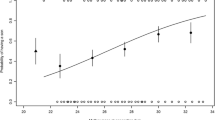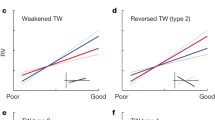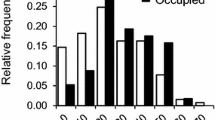Abstract
Studies of mammals have often produced results inconsistent with theories predicting adaptive sex-ratio manipulation. Some apparently strong trends weaken or disappear over time, suggesting that multiple variables affect sex ratio and that their relative importance may change over time. Mountain goats are sexually dimorphic ungulates that satisfy all the assumptions of the Trivers-Willard hypothesis. Therefore, females able to provide high levels of maternal care are expected to produce an excess of sons. An earlier study found that older females, that are larger and dominant, produced more sons than did younger females, which are smaller and subordinate. Here, we show that, as sample size tripled, that trend disappeared. A large-scale climate index, reproductive status at conception, and population density had no consistent effects on offspring sex ratio. A composite measure of female condition at conception revealed that offspring sex ratio varied with adult sex ratio, as predicted by the homeostatic hypothesis, but only for mothers in good condition at conception. These females were dominant, heavier, and older. Their probability of producing a son decreased from about 80 to 20 % as the adult sex ratio became more male-biased. For mothers with a low condition index, however, adult sex ratio had no effect on offspring sex ratio. Our research suggests that offspring sex ratio is affected by complex interactions between individual condition and other variables, whose importance may vary over time and can only be elucidated by long-term studies.




Similar content being viewed by others
References
Baeta R, Bélisle M, Garant D (2012) Importance of breeding season and maternal investment in studies of sex-ratio adjustment: a case study using tree swallows. Biol Lett 8:401–404
Bassano B, von Hardenberg A, Pelletier F, Gobbi G (2003) A method to weigh free-ranging ungulates without handling. Wildlife Soc B 31:1205–1209
Bates D, Maechler M, Bolker BM (2014) lme4: linear mixed-effects models using Eigen and S4. R package version 1.1-8, http://CRAN.R-project.org/package=lme4
Bérubé CH, Festa-Bianchet M, Jorgenson JT (1996) Reproductive costs of sons and daughters in Rocky Mountain bighorn sheep. Behav Ecol 7:60–68
Bradshaw CJA, Harcourt RG, Davis LS (2003) Male-biased sex ratios in New Zealand fur seal pups relative to environmental variation. Behav Ecol Sociobiol 53:297–307
Brown GR, Silk JB (2002) Reconsidering the null hypothesis: is maternal rank associated with birth sex ratios in primate groups? Proc Natl Acad Sci U S A 99:11252–11255
Burnham KP, Anderson DR (2002) Model selection and multimodel inference: a practical information-theoretic approach, 2nd edn. Springer, New York
Cameron EZ (2004) Facultative adjustment of mammalian sex ratios in support of the Trivers-Willard hypothesis: evidence for a mechanism. Proc R Soc Lond B 271:1723–1728
Cameron EZ, Lemons PR, Bateman PW, Bennett NC (2008) Experimental alteration of litter sex ratios in a mammal. Proc R Soc Lond B 275:323–327
Cattell RB (1966) The Scree test for the number of factors. Multivar Behav Res 1:245–276
Clutton-Brock TH, Albon SD, Guinness FE (1984) Maternal dominance, breeding success and birth sex ratios in red deer. Nature 308:358–360
Clutton-Brock TH, Albon SD, Guinness FE (1985) Parental investment and sex differences in juvenile mortality in birds and mammals. Nature 313:131–133
Clutton-Brock TH, Green D, Hiraiwa-Hasegawa M, Albon SD (1988) Passing the buck: resource defence, lek breeding and mate choice in fallow deer. Behav Ecol Sociobiol 23:281–296
Clutton-Brock TH, Sheldon BC (2010) Individuals and populations: the role of long-term, individual-based studies of animals in ecology and evolutionary biology. Trends Ecol Evol 25:562–573
Core Team R (2015) R: a language and environment for statistical computing. R Foundation for Statistical Computing, Vienna, Austria
Côté SD (2000) Dominance hierarchies in female mountain goats: stability, aggressiveness and determinants of rank. Behaviour 137:1541–1566
Côté SD, Festa-Bianchet M (2001a) Offspring sex ratio in relation to maternal age and social rank in mountain goats. Behav Ecol Sociobiol 49:260–265
Côté SD, Festa-Bianchet M (2001b) Reproductive success in female mountain goats: the influence of maternal age and social rank. Anim Behav 62:173–181
Côté SD, Festa-Bianchet M (2001c) Birthdate, mass and survival in mountain goat kids: effects of maternal characteristics and forage quality. Oecologia 127:230–238
Côté SD, Festa-Bianchet M, Fournier F (1998) Life-history effects of chemical immobilization and radiocollars on mountain goats. J Wildlife Manage 62:745–752
Cunningham JA, Hamlin KL, Lemke TO (2009) Fetal sex ratios in Southwestern Montana elk. J Wildlife Manage 75:639–646
de Vries H (1998) Finding a dominance order most consistent with a linear hierarchy: a new procedure and review. Anim Behav 55:827–843
Edwards AM, Cameron EZ (2014) Forgotten fathers: paternal influences on mammalian sex allocation. Trends Ecol Evol 29:158–164
Festa-Bianchet M (1996) Offspring sex ratio studies of mammals: does publication depend upon the quality of the data or the direction of the results? Écoscience 3:42–44
Festa-Bianchet M, Côté SD (2008) Mountain goats: ecology, behavior and conservation of a mountain ungulate. Island Press, Washington
Fisher RA (1930) The genetical theory of natural selection. Clarendon, Oxford
Gedir JV, Michener GR (2014) Litter sex ratios in Richardson’s ground squirrels: long-term data support random sex allocation and homeostasis. Oecologia 174:1225–1239
Gelman A (2008) Scaling regression inputs by dividing by two standard deviations. Stat Med 27:2865–2873
Gomendio M, Malo AF, Soler AJ, Fernandez-Santos MR, Esteso MC, Garcia AJ, Roldan ERS, Garde J (2006) Male fertility and sex ratio at birth in red deer. Science 314:1445–1447
Hamel S, Côté SD, Festa-Bianchet M (2010) Maternal characteristics and environment affect the costs of reproduction in female mountain goats. Ecology 91:2034–2043
Hamel S, Côté SD, Gaillard J-M, Festa-Bianchet M (2009a) Individual variation in reproductive costs of reproduction: high-quality females always do better. J Anim Ecol 78:143–151
Hamel S, Gaillard J-M, Festa-Bianchet M, Côté SD (2009b) Individual quality, early-life conditions, and reproductive success in contrasted populations of large herbivores. Ecology 90:1981–1995
Haviernick M, Côté SD, Festa-Bianchet M (1998) Immobilization of mountain goats with xylazine and reversal with idazoxan. J Wildlife Dis 34:342–347
Hewison AJM, Angibault JM, Boutin J, Bideau E, Vincent JP, Sempéré A (1976) Annual variation in body composition of roe deer (Capreolus capreolus) in moderate environmental conditions. Can J Zool 74:245–253
Hewison AJM, Gaillard J-M (1999) Successful sons or advantaged daughters? The Trivers-Willard model and sex-biased maternal investment in ungulates. Trends Ecol Evol 14:229–234
Hogg JT, Forbes SH (1997) Mating in bighorn sheep: frequent male reproduction via a high-risk "unconventional" tactic. Behav Ecol Sociobiol 41:33–48
Husson F, Josse J (2014) missMDA: handling missing values with/in multivariate data analysis (principal component methods). R package version 1.7.3, http://CRAN.R-project.org/package=missMDA
Kruuk LEB, Clutton-Brock TH, Albon SD, Pemberton JM, Guinness FE (1999) Population density affects sex ratio variation in red deer. Nature 399:459–461
Leimar O (1996) Life-history analysis of the Trivers and Willard sex-ratio problem. Behav Ecol 7:316–325
Littell RC, Stroup WW, Freund RJ (2002) SAS for linear models, 4th edn. SAS Institute Inc, North Carolina
Mainguy J (2008) Variabilité génétique et reproduction des mâles chez la chèvre de montagne. Université Laval, Dissertation
Mainguy J, Côté SD (2008) Age- and state-dependent reproductive effort in male mountain goats, Oreamnos americanus. Behav Ecol Sociobiol 62:935–943
Mainguy J, Côté SD, Festa-Bianchet M, Coltman DW (2009) Father–offspring phenotypic correlations suggest intralocus sexual conflict for a fitness-linked trait in a wild sexually dimorphic mammal. Proc R Soc Lond B 276:4067–4075
Martin JGA, Festa-Bianchet M (2011) Sex ratio bias and reproductive strategies: what sex to produce when? Ecology 92:441–449
Møller AP, Jennions MD (2001) Testing and adjusting for publication bias. Trends Ecol Evol 16:580–586
Noldus Information Technology (1998) Matman, Reference Manual. Wageningen, The Netherlands, http://www.noldus.com/knowledge-base/matman
Røed KH, Holand Ø, Mysterud A, Tverdal A, Kumpula J, Nieminen M (2007) Male phenotypic quality influences offspring sex ratio in a polygynous ungulate. Proc R Soc Lond B 274:727–733
Schielzeth H (2010) Simple means to improve the interpretability of regression coefficients. Method Ecol Evol 1:103–113
Schwanz LE, Robert KA (2014) Proximate and ultimate explanations of mammalian sex allocation in a marsupial model. Behav Ecol Sociobiol 68:1085–1096
Sheldon BC, West SA (2004) Maternal dominance, maternal condition, and offspring sex ratio in ungulate mammals. Am Nat 163:40–54
Stevens V, Houston DB (1989) Reliability of age determination of mountain goats. Wildlife Soc B 17:72–74
Taillon J, Brodeur V, Festa-Bianchet M, Côté SD (2011) Variation in body condition of migratory caribou at calving and weaning: which measures should we use? Ecoscience 18:295–303
Théoret-Gosselin R, Hamel S, Côté SD (2015) The role of maternal behavior and offspring development in the survival of mountain goat kids. Oecologia 178:175–186
Trenberth KE, Hurrell JW (1994) Decadal atmosphere–ocean variations in the Pacific. Clim Dynam 9:303–319
Trivers RL, Willard DE (1973) Natural selection of parental ability to vary the sex ratio of offspring. Science 179:90–92
Weladji RB, Holand Ø, Steinheim G, Lenvik D (2003) Sex-specific preweaning maternal care in reindeer (Rangifer tarandus t.). Behav Ecol Sociobiol 53:308–314
Werren JH, Charnov EL (1978) Facultative sex ratios and population dynamics. Nature 272:349–350
Williams GC (1979) The question of adaptive sex ratio in outcrossed vertebrates. Proc R Soc Lond B 205:567–580
Acknowledgments
Our long-term research is primarily financed by the Natural Sciences and Engineering Research Council of Canada. We also obtained support from the Alberta Fish and Wildlife Division, the Rocky Mountain Goat Foundation, the Alberta Conservation Association, the Alberta Sport, Recreation, Parks and Wildlife Foundation, the Alberta Wildlife Enhancement Fund, Université de Sherbrooke and Université Laval. We are indebted to the many people who helped with fieldwork at Caw Ridge over the years, and to K. G. Smith for his role in the initiation of the study. We thank two anonymous reviewers for constructive comments on a previous version of this manuscript.
Author information
Authors and Affiliations
Corresponding author
Ethics declarations
The authors declare that they have no competing interests.
Compliance with ethical standards
All procedures performed in studies involving animals were in accordance with the ethical standards of the institution or practice at which the studies were conducted.
Additional information
Communicated by K. E. Ruckstuhl
Rights and permissions
About this article
Cite this article
Hamel, S., Festa-Bianchet, M. & Côté, S.D. Offspring sex in mountain goat varies with adult sex ratio but only for mothers in good condition. Behav Ecol Sociobiol 70, 123–132 (2016). https://doi.org/10.1007/s00265-015-2031-9
Received:
Revised:
Accepted:
Published:
Issue Date:
DOI: https://doi.org/10.1007/s00265-015-2031-9




